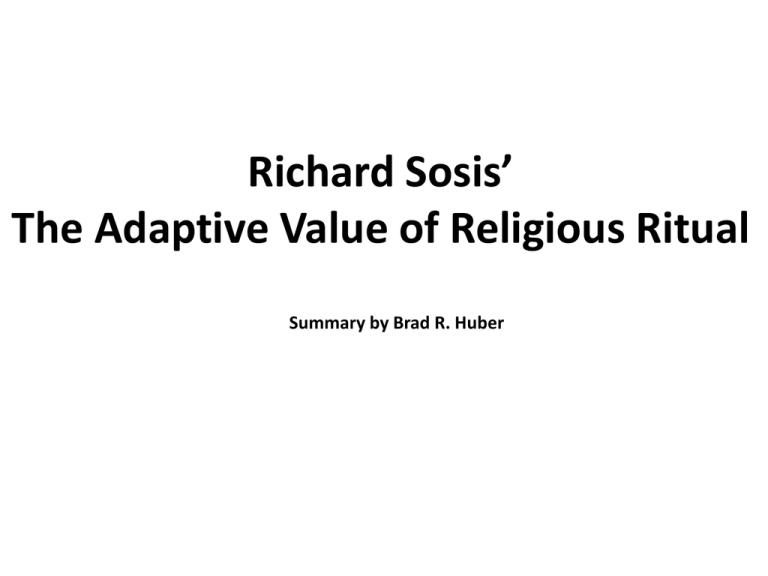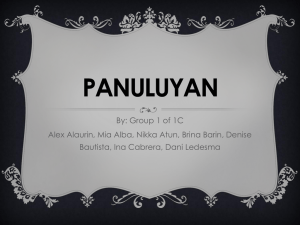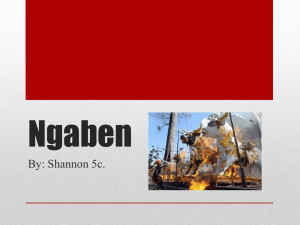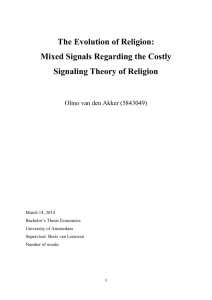
Richard Sosis’
The Adaptive Value of Religious Ritual
Summary by Brad R. Huber
Introduction
Many religious acts appear peculiar to the outsider.
a.Moonies shave their heads (Not now, perhaps
in the past)
b.Clergy dress in outfits that distinguish them
from the rest of society. E.g., Bishops at
Conference of Canterbury
Many peoples also engage in some form of surgical
alteration:
a.Australian aborigine adolescent boys have a
bone or stone inserted into the penis.
b.Daughters are circumcised
c.Ritual scarification of Nuer
How can we understand such behavior?
Behavioral ecologists assume that natural selection
has designed our decision-making mechanisms.
Given environment “X”, what behaviors would
increase the likelihood of an individual’s survival
and reproduction?
So, why would we engage in religious behavior that
seems so counterproductive?
Indeed, some religious practices, such as ritual
sacrifices, are a conspicuous display of wasted
resources., E.g., Kwakiutl Potlatch
Why has natural selection favored a psychology
that believes in the supernatural and engages
in the costly manifestations of those beliefs.
Ritual Sacrifice
1.A new generation of anthropologists have
begun to provide some explanation:
2.The “strangeness” of religious practices and
their inherent costs are actually the critical
features that contribute to the success of
religious as a universal cultural strategy.
3.We need to recognize the adaptive problem
that ritual behavior solves.
1.William Irons suggested that a universal dilemma
is the promotion of cooperation with a
community.
2.Irons argues that the primary adaptive benefit of
religion is its ability to facilitate cooperation
within a group---while hunting, sharing food,
defending against attacks, and waging war.
3.Although everyone is better off if everybody
cooperates, this ideal is often very difficult to
coordinate and achieve.
1.Cooperation requires social
mechanisms that prevent
individuals from free riding on the
efforts of others.
1.Ethologists have recognized that ritualistic
behaviors served as a form of communication.
a.The vibration of a rattlesnake’s tail is a powerful
threat display to other species.
b.Courtship rituals---such as bowing, head
wagging, wing waving and hopping---to signal
amorous intents before a prospective mate.
1.Irons’ insight is that religious activities signal
commitment to other members of the group.
2.Through its ability to signal commitment,
religious behavior can
a. overcome the problem of free riders and
b. promote cooperation within the group.
3. It is a robust way to secure trust.
1.Israeli biologist Amotz Zahavi observes that it is
often in the best interest of an animal to send a
dishonest signal---perhaps to fake its size, speed,
strength, health, or beauty.
2.The only signal that can be believed is one that is
too costly to fake, which her referred to as a
“handicap”.
1.Zahavi argues that natural selection has favored
the evolution of handicaps.
2.For example, when a springbok antelope spots
a predator it often stots---jumps up and down.
https://www.youtube.com/watch?v=iIigVlcxwps
1.Why would an antelope waste precious energy
that could be used to escape the predator? And
why would the animal make itself more visible to
a predator?
2.The reason is that the springbok is displaying its
quality to the predator---its ability to escape.
3.The springbok is believed because the signal is too
costly to fake.
1. Religious behavior is also a costly signal.
a.Wearing layers of clothing and standing out in the
midday sun signals to other ultra-orthodox Jewish
men that they are members of this group and can be
trusted.
b.The quality these men are signaling is their level of
commitment to a specific religious group.
2. Adherence to a set of religious beliefs entails a host of
ritual obligations and expected behaviors.
3. The significant time, energy and financial costs
involved in some ritual practices serve as effective
deterrents for anyone who does not believe in the
teachings of a particular religion.
4. As a result of increased levels of trust and commitment
among group members, religious groups minimize costly
monitoring mechanisms that are otherwise necessary to
overcome free-rider problems
Benefits of Membership
1. One prediction of the “costly signaling theory of ritual” is that
groups that impose the greatest demands on their members will
elicit the highest levels of devotion and commitment.
2. This may explain a paradox: Churches that require the most of
their adherents are experiencing rapid rates of growth:
a. The Church of Jesus Christ of Latter-day Saints
b. Seventh-day Adventists
c. Jehovah’s Witnesses
1.The costly signaling theory of ritual also predicts
that greater commitment will translate into
greater cooperation within groups.
2.19th-century communes faced an inherent
problem of promoting and sustaining
cooperation because individuals can free ride on
the efforts of others.
1. Sosis and Eric Bressler used commune longevity as a
measure of cooperation.
2. Compared to their secular counterparts, religious
communes did indeed demand more of their
members such as celibacy, the surrender of all
material possessions.
3. Communes that demanded more of their members
survived longer, overcoming the fundamental
challenges of cooperation.
1.The costly signaling theory of ritual was also
evaluated within modern communal societies.
2.The kibbutzim provided an ideal opportunity to
examine this hypothesis.
3.For 100 years, these communes lived by the
dictum, “From each according to his abilities, to
each according to his needs.”
4. The majority of the 270 kibbutzim are secular;
fewer than 20 are religiously oriented.
5.Because of debt, the kibbutzim are moving in
the direction of increased privatization and
reduced communality.
6.In the 1980s, we found out that the religious
kibbutzim were financially stable while the
secular ones were not.
7. The success of the religious kibbutzim is especially
remarkable given that many of their rituals inhibit
economic productivity.
a.For example, Jewish law does not permit Jews to milk
cows on the Sabbath.
b.And fruits are not allowed to be eaten for the first
few years of the tree’s life,
c. agricultural fields must lie fallow every seven years,
and
d.the corners of fields can never be harvested---they
must be left for society’s poor.
1. Although these constraints appear detrimental to
productivity, the costly signaling theory of ritual
suggests that they may actually be the key to the
economic success of the religious kibbutzim.
2. Sosis and Economist Bradley Ruffle developed a game
to determine whether there were differences in how
the members of secular and religious kibbutzim
cooperated with each other.
3. The game required individuals use selfrestraint---cooperation.
4. Religious kibbutzniks were more cooperative
with each other than secular kibbutzniks, and
male religious kibbutzniks were more
cooperative than female members.
1. Why? Male rituals are largely performed in public, and
those men who attended synagogue regularly were
the most cooperative.
2. Why are human rituals often cloaked in mystery and
the supernatural?
3. Cognitive anthropologists Scott Atran and Pascal Boyer
point out that the counterintuitive nature of
supernatural concepts are attention-arresting and
more easily remembered than mundane ideas
4. This facilitates their cultural transmission.
1.For example,
a. Totemic animals that can talk
b. Dead ancestors who demand sacrificial
offerings and visit the living
c. Incorporeal beings capable of being in all
places at all times
d. Transmutation of wine to blood
2.Believers verify supernatural concepts
“emotionally”.
1. Unfortunately there is also a dark side to religious
unity.
a. If the intra-group solidarity that religion promotes
is one of its significant adaptive benefits,
b. then religion has probably always played a role in
intergroup conflicts.
2. One of the benefits for individuals of intra-group
solidarity is the ability of unified groups to defend and
compete against other groups.
5. Kibbutz: Socialism on a Human Scale (07:03; From the
Video Unstable Utopias: The Global Spread of Socialism;
Films on Demand)










